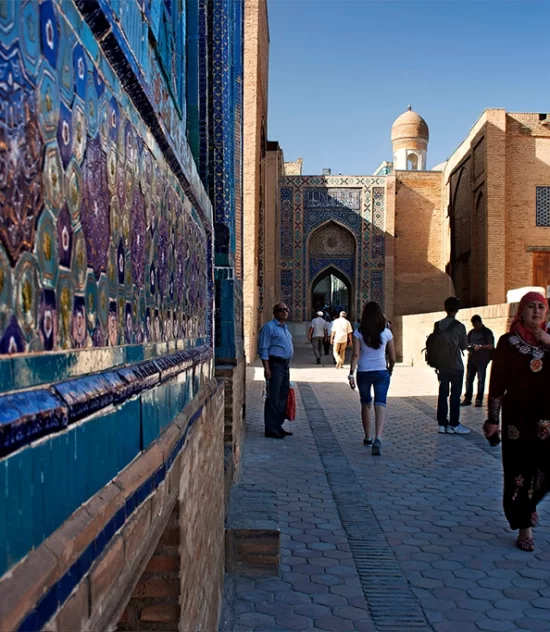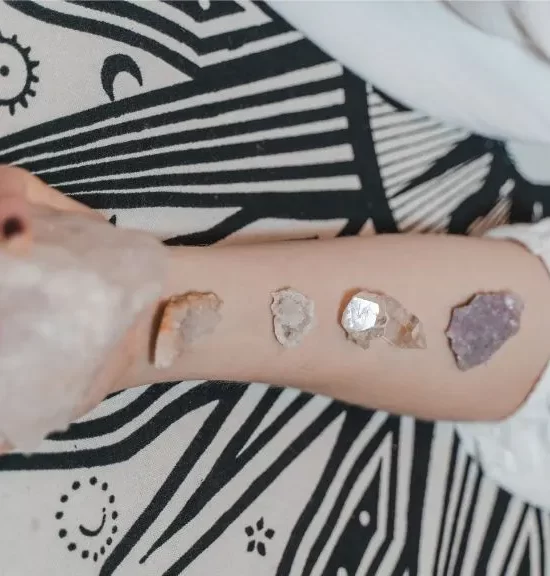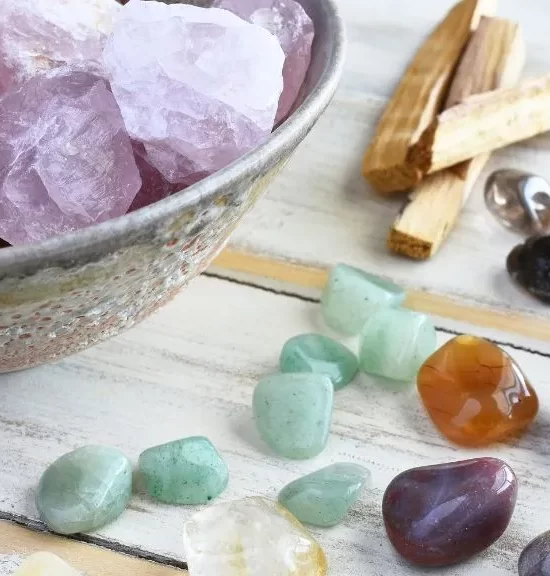Lapis Lazuli
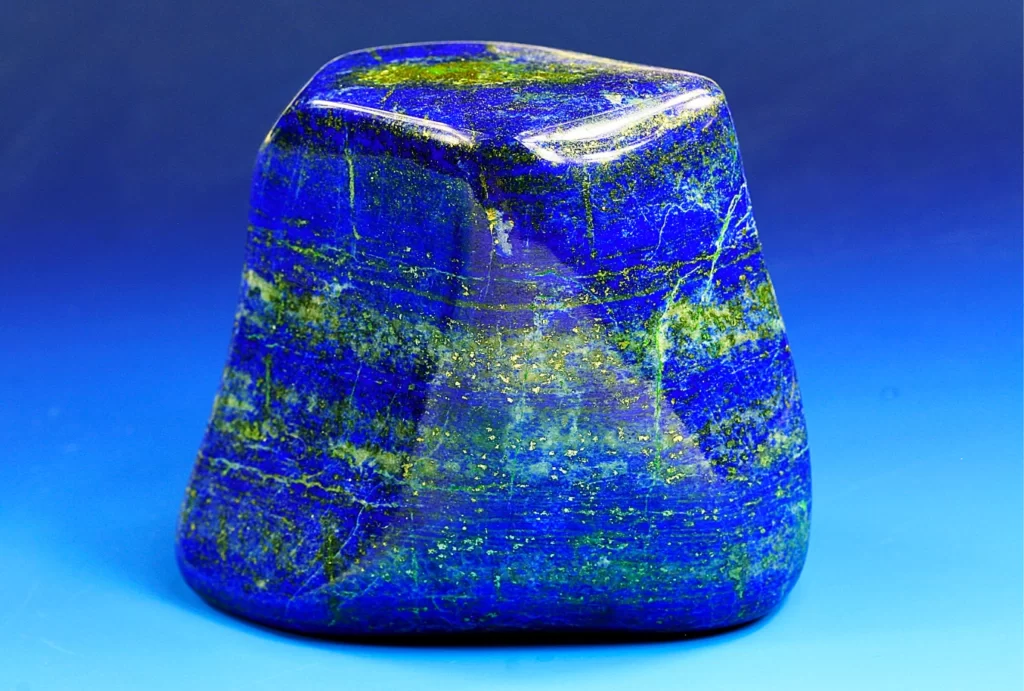
Lapis Lazuli Crystal Meaning and Uses
Lapis Lazuli is a beautiful blue crystal that has been revered for its healing properties for thousands of years. This stone has been used by ancient civilizations such as the Egyptians, Greeks, and Romans for both spiritual and medicinal purposes. It was believed to have mystical powers that could bring enlightenment, inner peace, and wisdom to the wearer.
Lapis Lazuli is said to have a calming effect on the mind and emotions, which can help to reduce anxiety, stress, and depression. It is also believed to enhance intuition, creativity, and communication, making it a popular choice for artists, writers, and performers. Additionally, Lapis Lazuli is said to have physical healing properties, particularly for the throat, lungs, and nervous system.
Lapis Lazuli is a powerful crystal that is valued for its ability to promote healing and balance in the body, mind, and spirit. Its deep blue color and shimmering appearance make it a beautiful addition to any collection, and its healing properties make it a popular choice for those seeking natural remedies for a variety of physical and emotional ailments.
Lapis Lazuli is the Crystal of Communication
Lapis Lazuli is known for its healing properties, and it can be used to help reduce stress and anxiety, enhance wisdom and truth, as well as promote self-awareness. It is believed to be a powerful crystal for spiritual healing, so it can be a great addition to your meditation practice.
To maximize the healing benefits of Lapis Lazuli, you can wear it as jewelry or carry it in a pocket, or place it in an area of your home where you spend a lot of time. You can also create a crystal grid with the stone, and visualize it radiating its healing energy throughout your space.
Healing Overview
- Reduces Stress and Anxiety
- Improves Communication
- Reveals Truth
- Brings Inner Peace

Lapis Lazuli with Meditation
Lapis Lazuli is a beautiful deep blue crystal that has been valued for its healing properties for centuries. In addition to being a popular gemstone, Lapis Lazuli is also widely used in meditation practices for its ability to promote inner peace, self-awareness, and healing on multiple levels. Here are some of the key benefits of using Lapis Lazuli while meditating…
Promotes Relaxation and Reduces Stress
Meditation is a great way to reduce stress and promote relaxation, and Lapis Lazuli can help to enhance these benefits. The deep blue color of Lapis Lazuli is associated with calmness and tranquility, which can help to soothe the mind and reduce anxiety.
Enhances Self-Awareness and Intuition
Lapis Lazuli is often used to enhance intuition and spiritual awareness, making it a great crystal to use during meditation. When you meditate with Lapis Lazuli, you can connect more deeply with your inner self and gain greater insight into your thoughts and emotions.
Supports Healing and Recovery
Lapis Lazuli is also known for its healing properties, making it a great crystal to use if you’re recovering from an illness or injury. The crystal is said to help boost the immune system and promote overall wellness, making it a valuable tool for those seeking to improve their physical health.
Improves Communication and Expression
Lapis Lazuli is associated with the throat chakra, which governs communication and self-expression. When this chakra is balanced, you can communicate more effectively and express yourself more authentically. Meditating with Lapis Lazuli can help to balance this chakra, improving your ability to communicate and express yourself.
Promotes Spiritual Growth and Connection
Lapis Lazuli has long been associated with spiritual growth and enlightenment, making it a powerful tool for those on a spiritual journey. When you meditate with Lapis Lazuli, you can connect more deeply with your spiritual self and gain greater insight into the mysteries of the universe.
There are many benefits to using Lapis Lazuli while meditating. Whether you’re looking to reduce stress, improve your physical health, or connect more deeply with your spiritual self, this beautiful crystal can help you achieve your goals. So if you’re looking to enhance your meditation practice, consider incorporating Lapis Lazuli into your routine and experience its transformative power for yourself.
How to Use Lapis Lazuli During Meditation
When used during meditation, Lapis Lazuli crystals can help to promote inner peace, self-awareness, and healing on multiple levels.
To use Lapis Lazuli crystals during meditation for healing, follow these steps:
Find a quiet, peaceful space where you can meditate without distraction. Set your intention for your meditation and hold your Lapis Lazuli crystal in your hand.
Begin by focusing on your breath, allowing yourself to become fully present in the moment. As you inhale, imagine yourself drawing in healing energy from the universe, and as you exhale, release any negative or stagnant energy from your body.
As you continue to breathe deeply, visualize the energy of the Lapis Lazuli crystal flowing into your body, filling you with its healing properties. Imagine the deep blue color of the crystal spreading throughout your body, bringing a sense of calm and tranquility.
You can also hold the crystal to different parts of your body that need healing, such as your heart, throat, or third eye. As you do so, visualize the crystal’s energy penetrating deeply into those areas, bringing healing and balance.
Continue to meditate with the Lapis Lazuli crystal for as long as feels comfortable, allowing yourself to fully absorb its healing properties. When you’re ready to end your meditation, take a few deep breaths and slowly come back to the present moment.
Overall, using Lapis Lazuli crystals during meditation can be a powerful way to promote healing and inner peace. Whether you’re looking to heal physical ailments or emotional wounds, this crystal can help to bring balance and clarity to your mind, body, and spirit.
Lapis Lazuli for the Throat Chakra

The throat chakra, also known as the Vishuddha chakra, is the fifth chakra and is located in the throat area. This chakra governs communication, self-expression, and creativity, and when it is balanced, we are able to express ourselves confidently and authentically.
Lapis Lazuli is a powerful crystal that is associated with the throat chakra, and it can be used to balance and activate this chakra.
The deep blue color of Lapis Lazuli is associated with the throat chakra, making it a powerful tool for balancing and activating this chakra. The crystal is said to stimulate the throat chakra, allowing for clear communication and expression.
If you’re looking to balance your throat chakra, using Lapis Lazuli can be an effective way to do so.
How to use Lapis Lazuli to Balance your Throat Chakra
Choose a Lapis Lazuli crystal that resonates with you. You can choose a tumbled stone or a piece of jewelry that contains Lapis Lazuli.
Find a quiet, peaceful space where you won’t be disturbed. Sit comfortably and hold the Lapis Lazuli crystal in your hand.
Close your eyes and take a few deep breaths. As you inhale, imagine the energy of the Lapis Lazuli crystal flowing into your body, filling your throat area with its healing properties.
Visualize the energy of the crystal penetrating deeply into your throat chakra. Imagine the chakra becoming balanced and activated, allowing for clear communication and expression.
Repeat a mantra or affirmation that resonates with you, such as “I speak my truth with confidence and authenticity.”
Continue to meditate with the Lapis Lazuli crystal for as long as feels comfortable. When you’re ready to end your meditation, take a few deep breaths and slowly come back to the present moment.
Using Lapis Lazuli to balance the throat chakra can be a powerful way to improve your communication and self-expression. By incorporating this beautiful crystal into your meditation practice, you can tap into its transformative power and achieve greater clarity and authenticity in your interactions with others.
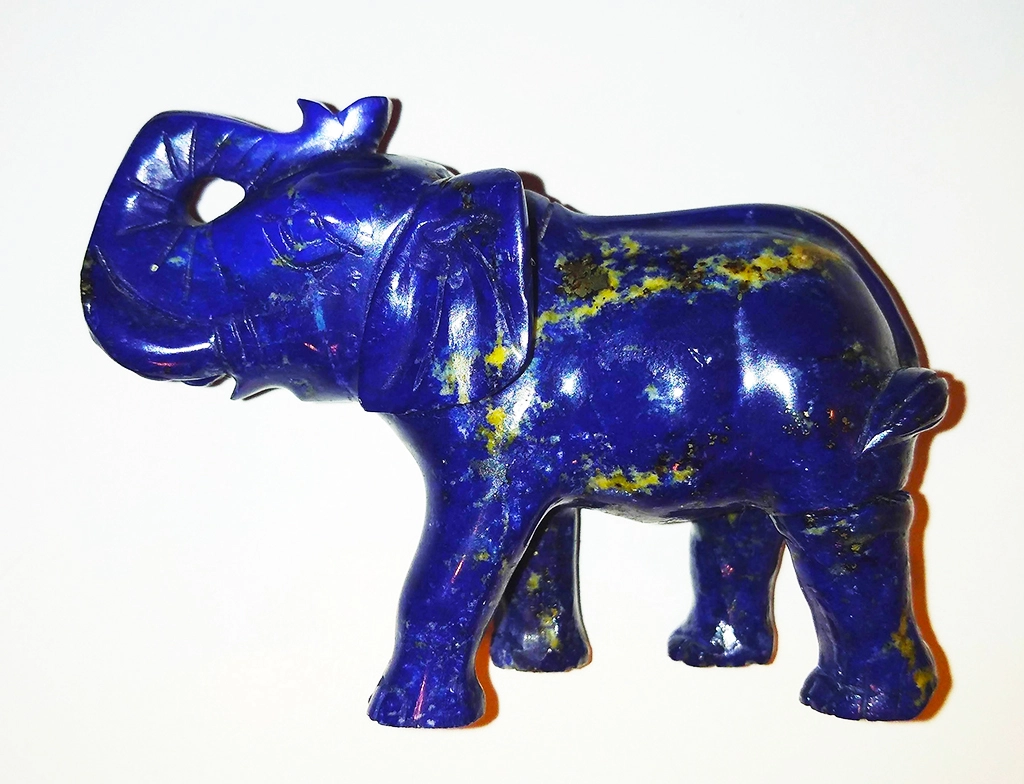
Birthstone, Anniversary, and Zodiac
Lapis Lazuli is the traditional birthstone of December. It is also associated with those born in September.
Lapis Lazuli is often given as the 7th and 9th anniversary stone.
Lapis Lazuli crystals are strongly associated with Sagittarius and Libra. However, it has benefits for all zodiac signs.
Lapis Lazuli for Each Zodiac Sign
Lapis Lazuli is a beautiful blue crystal that has been valued for its healing properties for centuries. It is associated with the throat chakra and is known for its ability to promote communication, self-expression, and creativity. In addition to these benefits, Lapis Lazuli can also help each zodiac sign in unique ways. Here’s what you need to know about how Lapis Lazuli can benefit your zodiac sign:
Aries (March 21 – April 19)
As a fire sign, Aries can be impulsive and quick to anger. Lapis Lazuli can help to calm their energy and promote greater self-awareness. The crystal can also help Aries to communicate more effectively, allowing them to express themselves with greater clarity and confidence.
Taurus (April 20 – May 20)
Taurus is a practical earth sign that values stability and security. Lapis Lazuli can help to balance their energy and promote a greater sense of inner peace. The crystal can also help Taurus to tap into their creative side and express themselves in new and innovative ways.
Gemini (May 21 – June 20)
As an air sign, Gemini is known for their quick wit and communication skills. Lapis Lazuli can help to enhance their natural abilities and promote greater self-expression. The crystal can also help Gemini to stay focused and grounded, preventing them from becoming scattered or overwhelmed.
Cancer (June 21 – July 22)
Cancer is a water sign that is deeply connected to their emotions. Lapis Lazuli can help to promote emotional balance and stability, allowing Cancer to communicate their feelings with greater clarity and confidence. The crystal can also help to protect Cancer from negative energy and promote greater spiritual awareness.
Leo (July 23 – August 22)
As a fire sign, Leo is passionate and creative. Lapis Lazuli can help to enhance their natural abilities and promote greater self-expression. The crystal can also help Leo to communicate their ideas with greater confidence, allowing them to inspire others and make a positive impact in the world.
Virgo (August 23 – September 22)
Virgo is a practical earth sign that values organization and efficiency. Lapis Lazuli can help to promote greater clarity and focus, allowing Virgo to communicate their ideas and strategies with greater effectiveness. The crystal can also help to enhance Virgo’s creativity, allowing them to approach problems from new and innovative angles.
Libra (September 23 – October 22)
Libra is an air sign that values harmony and balance. Lapis Lazuli can help to promote greater emotional balance and stability, allowing Libra to communicate their feelings with greater clarity and confidence. The crystal can also help Libra to tap into their creativity and express themselves in new and innovative ways.
Scorpio (October 23 – November 21)
Scorpio is a water sign that is deeply connected to their emotions. Lapis Lazuli can help to promote emotional balance and stability, allowing Scorpio to communicate their feelings with greater clarity and confidence. The crystal can also help to enhance Scorpio’s intuition, allowing them to connect with their inner wisdom and make decisions from a place of greater insight.
Sagittarius (November 22 – December 21)
As a fire sign, Sagittarius is adventurous and independent. Lapis Lazuli can help to promote greater emotional balance and stability, allowing Sagittarius to communicate their feelings with greater clarity and confidence. The crystal can also help to enhance Sagittarius’s creativity, allowing them to express themselves in new and exciting ways.
Capricorn (December 22 – January 19)
Capricorn is a practical earth sign that values hard work and achievement. Lapis Lazuli can also help Capricorn to tap into their intuition and connect with their spiritual side, allowing them to approach their goals with greater insight and inspiration.
Aquarius (January 20 – February 18)
Aquarius is an air sign that values independence and innovation. Lapis Lazuli can help to promote emotional balance and stability, allowing Aquarius to communicate their feelings with greater clarity and confidence. The crystal can also help to enhance Aquarius’s creativity, allowing them to approach problems from new and innovative angles.
Pisces (February 19 – March 20)
Pisces is a water sign that is deeply connected to emotions and intuition. Lapis Lazuli can help to promote emotional balance and stability, allowing Pisces to communicate their feelings with greater clarity and confidence. The crystal can also help Pisces to connect with their intuition and tap into their spiritual side, allowing them to approach their life with greater insight and inspiration.
In conclusion, Lapis Lazuli is a beautiful crystal that can benefit each zodiac sign in unique ways. Whether you’re looking to enhance your communication skills, tap into your creativity, or connect with your intuition, Lapis Lazuli can help you achieve your goals and lead a more fulfilling life.
Lapis Lazuli History in Ancient Cultures
Lapis Lazuli has been prized for its beauty and value for thousands of years. Its name comes from the Latin word “lapis,” which means stone, and lazulī is the genitive form of the Medieval Latin lazulum, which is taken from the Arabic lāzurd, meaning sky or heaven. This gemstone has a rich history and has been used for many purposes throughout ancient times.
The history of Lapis Lazuli dates back to the ancient civilizations of Mesopotamia, Egypt, and the Indus Valley. It was highly valued for its intense blue color, which was believed to be a symbol of royalty and divinity. In ancient Egypt, Lapis Lazuli was used in jewelry and amulets, and it was believed to have magical properties that could protect the wearer from harm.
In ancient Sumer, Lapis Lazuli was also used for religious purposes. It was believed to have the power to ward off evil spirits and was often used in temple decoration. The Babylonians used Lapis Lazuli to create cylinder seals, which were used to imprint images onto clay tablets. The seals were often carved with intricate designs and scenes from mythology.
The ancient Greeks and Romans also valued Lapis Lazuli. It was used to create jewelry, statues, and vases, and it was believed to have healing properties. The philosopher Aristotle wrote about the stone’s healing properties, and it was often used in medicine to treat a variety of ailments.
During the Renaissance period in Europe, Lapis Lazuli became even more popular. It was used to create the pigment ultramarine, which was one of the most expensive pigments used in art at the time. Paintings that used ultramarine were considered to be of higher value and were often reserved for royalty and the wealthiest members of society.
In addition to its use in art and jewelry, Lapis Lazuli has also been used for spiritual purposes. In many cultures, it is believed to promote self-awareness and enlightenment. It is associated with the throat chakra, which is believed to be the center of communication and self-expression. Lapis Lazuli is often used in meditation and is believed to help individuals connect with their higher selves.
In conclusion, Lapis Lazuli has a rich history and has been used for many purposes throughout ancient times. It has been valued for its beauty, spiritual properties, and healing properties. Today, Lapis Lazuli remains a popular gemstone and is still used in jewelry and art. Its deep blue color and history make it a valuable and fascinating stone.

Cleansing Lapis Lazuli
Lapis Lazuli can be cleansed using various methods, depending on personal preference and the specific use of the stone. Here are some common ways to cleanse Lapis Lazuli:
Water: Lapis Lazuli can be gently rinsed under cool running water to remove any physical debris or energetic impurities. Be sure to dry the stone thoroughly afterward to prevent any water stains.
Saltwater: Another option is to cleanse Lapis Lazuli with a solution of saltwater. You can fill a bowl with lukewarm water and add a tablespoon of sea salt. Then place your Lapis Lazuli in the water and let it soak for a few minutes. Rinse the stone with cool water and dry it thoroughly afterward.
Smudging: You can cleanse Lapis Lazuli by smudging it with sage, palo santo, or other cleansing herbs. Light the herb bundle or stick, and hold the Lapis Lazuli in the smoke for several seconds, being careful not to burn the stone or yourself.
Sunlight/Moonlight: Placing Lapis Lazuli in sunlight or moonlight can also help to cleanse and recharge the stone. Leave it in direct sunlight or moonlight for several hours, preferably on a natural surface like a piece of wood or a leaf.
Sound: Sound can also be used to cleanse Lapis Lazuli. You can use a singing bowl or a bell to produce a clear, high-pitched sound near the stone to help clear any negative energy or impurities.
Lapis Lazuli Physical Healing
Lapis Lazuli has been used for centuries for its alleged healing properties, particularly for physical ailments related to the throat and respiratory system. Here is some information about using Lapis Lazuli for physical healing:
- Respiratory health: Lapis Lazuli is said to have a soothing effect on the respiratory system and may be useful for those with respiratory conditions like asthma, bronchitis, or allergies. It is believed to help reduce inflammation and support healthy breathing.
- Pain relief: Lapis Lazuli is also said to have pain-relieving properties and may be helpful for conditions like headaches, migraines, and joint pain. It is believed to have an analgesic effect and may help to reduce inflammation and swelling.
- Immune system support: Lapis Lazuli is said to support the immune system and may be useful for those with chronic infections or weakened immune systems. It is believed to have antibacterial and antiviral properties, which may help to fight off infections and illnesses.
- Throat health: Lapis Lazuli is often associated with the throat chakra and is said to promote healthy communication and self-expression. It may also be helpful for those with throat-related issues like sore throat, laryngitis, or thyroid problems.
To use Lapis Lazuli for physical healing, you can wear it as jewelry, carry it in your pocket, or place it on the affected area of your body. Some people also use Lapis Lazuli in combination with other healing practices, like meditation or Reiki, to enhance its effects. However, it’s important to note that Lapis Lazuli is not a substitute for medical treatment and should be used in conjunction with professional medical advice and care.
Lapis Lazuli Mental Healing
Lapis Lazuli is also believed to have mental and emotional healing properties and has been used for centuries for its alleged benefits in promoting clarity, wisdom, and inner peace. Here is some information about using Lapis Lazuli for mental healing:
- Mental clarity: Lapis Lazuli is said to promote mental clarity and focus, helping to clear away mental fog and confusion. It may be helpful for those struggling with indecision, self-doubt, or lack of direction.
- Emotional balance: Lapis Lazuli is believed to promote emotional balance and stability, helping to alleviate feelings of stress, anxiety, and depression. It may be helpful for those who struggle with mood swings, emotional volatility, or negative self-talk.
- Spiritual growth: Lapis Lazuli is often associated with the third eye and crown chakras and is said to promote spiritual growth and awareness. It may be helpful for those seeking to deepen their spiritual practice or connect with higher consciousness.
- Self-expression: Lapis Lazuli is also believed to promote healthy communication and self-expression, helping to foster more authentic and meaningful connections with others. It may be helpful for those who struggle with speaking their truth or expressing themselves creatively.
To use Lapis Lazuli for mental healing, you can wear it as jewelry, carry it in your pocket, or place it on your forehead during meditation. Some people also use Lapis Lazuli in combination with other healing practices, like visualization or affirmations, to enhance its effects. However, it’s important to note that Lapis Lazuli is not a substitute for professional mental health treatment and should be used in conjunction with appropriate care and support.
Lapis Lazuli Emotional Healing
Lapis Lazuli has been used for centuries for its emotional healing properties, particularly for promoting inner peace, emotional balance, and self-awareness. Here is some information about using Lapis Lazuli for emotional healing:
- Calming and soothing: Lapis Lazuli is said to have a calming and soothing effect on emotions, helping to alleviate feelings of anxiety, stress, and overwhelm. It may be helpful for those who struggle with emotional volatility or are going through a particularly challenging time.
- Self-awareness: Lapis Lazuli is believed to promote self-awareness and introspection, helping individuals to understand their emotions and underlying thought patterns. It may be helpful for those seeking to deepen their self-awareness and improve their emotional intelligence.
- Emotional balance: Lapis Lazuli is also said to promote emotional balance and stability, helping individuals to feel more centered and grounded. It may be helpful for those who struggle with mood swings or intense emotional reactions.
- Inner peace: Lapis Lazuli is often associated with the third eye and crown chakras and is believed to promote inner peace and spiritual growth. It may be helpful for those seeking to cultivate a greater sense of inner calm and tranquility.
To use Lapis Lazuli for emotional healing, you can wear it as jewelry, carry it in your pocket, or place it on your heart center during meditation. Some people also use Lapis Lazuli in combination with other healing practices, like journaling or therapy, to enhance its effects. However, it’s important to note that Lapis Lazuli is not a substitute for professional emotional health treatment and should be used in conjunction with appropriate care and support.
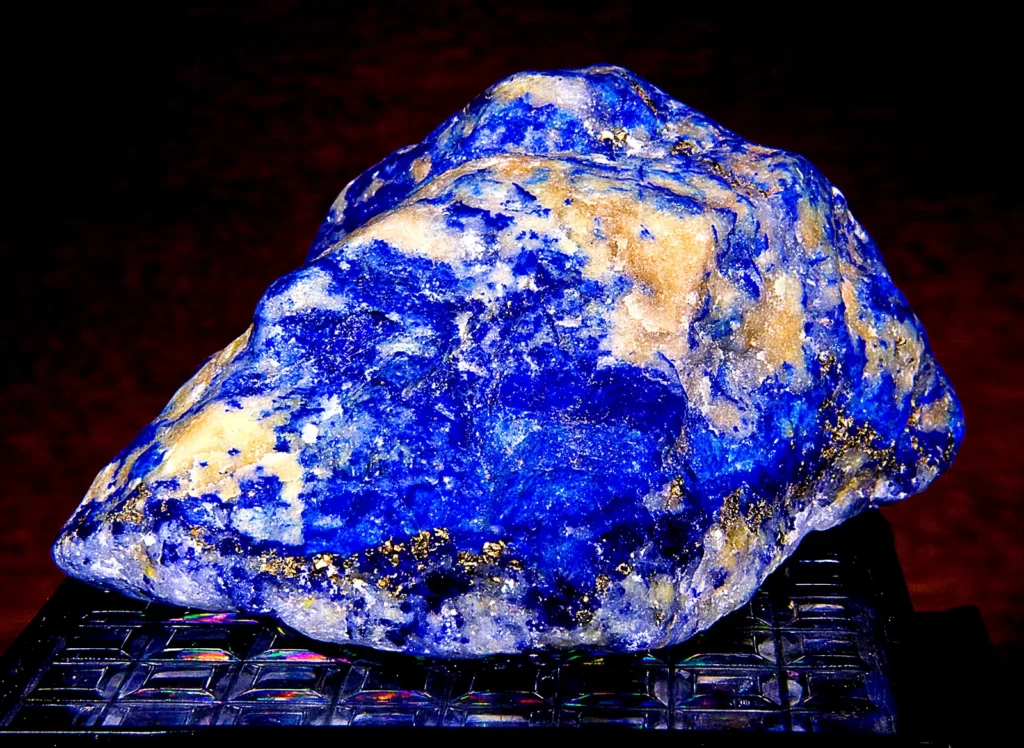
Lapis Lazuli FAQ
Can Lapis Lazuli go in the sun?
Yes. However, you do not want to keep this crystal in direct sunlight for prolonged periods of time as the color may fade.
Can Lapis Lazuli go in water?
Lapis Lazuli can go in water briefly but it’s not recommended. This crystal often includes Calcite which can dissolve in water and Pyrite which can become toxic in water.
What does Lapis Lazuli mean?
The name “Lapis Lazuli” comes from the Latin word “lapis,” meaning stone, and lazulī is the genitive form of the Medieval Latin lazulum, which is taken from the Arabic lāzurd, meaning sky or heaven. In ancient times, the stone was also known as “sapphire” or “sapphire stone,” although it is not related to the mineral corundum, which is the mineral that produces true sapphires.
Lapis Lazuli has been valued for thousands of years for its intense blue color and has been used for decorative purposes, jewelry, and pigment for artwork. The stone has also been attributed with various symbolic meanings throughout history, such as representing truth, wisdom, and spiritual enlightenment. It was even believed by some ancient civilizations to have healing properties and was ground into powder and used as a medicine.
How does Lapis Lazuli form?
Lapis Lazuli is a blue-colored metamorphic rock that is composed primarily of the mineral lazurite, along with other minerals such as calcite, pyrite, and sodalite.
The formation of Lapis Lazuli begins with the metamorphism of a rock called limestone or dolomite, which is composed primarily of the mineral calcite. During metamorphism, the calcite in the limestone or dolomite recrystallizes and is replaced by other minerals, including lazurite.
The process of forming Lapis Lazuli involves the introduction of sulfur into the metamorphic environment, which reacts with pre-existing calcite in the rock to produce new minerals such as pyrite and lazurite. This reaction occurs under high pressure and temperature conditions, typically in contact with hydrothermal fluids, which are mineral-rich fluids that are circulated through the Earth’s crust.
Over time, the minerals in the rock continue to recrystallize and grow, leading to the formation of a solid mass of Lapis Lazuli. The color of Lapis Lazuli is due to the presence of the mineral lazurite, which gives the rock its distinctive blue hue.
What are the benefits of wearing Lapis Lazuli?
Lapis Lazuli is believed to have various benefits when worn as jewelry or carried as a talisman. Here are some of the potential benefits associated with wearing Lapis Lazuli:
- Enhancing self-awareness and self-expression: Lapis Lazuli is said to stimulate the throat chakra, which is associated with communication, self-expression, and creativity. Wearing Lapis Lazuli is believed to help individuals express their thoughts and emotions more clearly and confidently.
- Promoting mental clarity and focus: Lapis Lazuli is also believed to have a calming effect on the mind, helping to reduce stress, anxiety, and mental clutter. This can help individuals achieve a greater sense of mental clarity and focus, which may be beneficial for tasks that require concentration and problem-solving.
- Enhancing intuition and spiritual awareness: Lapis Lazuli is sometimes referred to as the “wisdom stone,” and is said to help individuals connect with their intuition and inner wisdom. It is also believed to promote spiritual awareness and growth, helping individuals deepen their understanding of themselves and the world around them.
- Providing protection and healing: Lapis Lazuli is said to have protective properties, shielding individuals from negative energy and promoting emotional healing. It is also believed to have physical healing properties, particularly for ailments related to the throat and respiratory system.
Where is Lapis Lazuli found?
Lapis Lazuli is found in various locations around the world, but historically the most famous and valuable deposits were located in Afghanistan, in the mountains of the Badakhshan province. The Sar-e-Sang mine in this region has been producing high-quality Lapis Lazuli for over 6,000 years and is still an important source of the stone today.
Other countries where Lapis Lazuli is found include Chile, Russia, Italy, and the United States (primarily in Colorado and California). In some cases, the quality and color of Lapis Lazuli found in these locations can vary, depending on the specific geological conditions and mineral content of the deposits.
How do you pronounce Lapis Lazuli?
The pronunciation of Lapis Lazuli is: LAH-pis LAZ-yoo-lee
Lapis Lazuli Photo Gallery
Share this Page:
Checkout Out the Latest
The Spiritual Significance of Crystals: Meditation, Divination, and Energy Healing
History and Uses of Crystals in Ancient Civilizations
How to Choose the Right Crystal for You
Healing Properties of Crystals: Exploring Potential Benefits
Image Credits
Lapis Lazuli from Afghanistan photo by David J. Eicher via Mindat
Lapis Lazuli Spheres photo by Adam Ognisty via Wikimedia
Elephant Carved from Lapis Lazuli photo by Adrian Pingstone via Wikimedia
Cleansing Crystals photo by Karolina Grabowska via Pexels
Lapis Lazuli on Tiled Surface by Orbital Joe via Flickr
Gallery photos by Adam Ognisty, Guy Courtois, Jonathan Cardy, Raulfj, Philippe Giabbanelli, Ruff tuff cream puff, James St. John, and Elade53
References
This post was written by Mystic Meow Crystals staff with sourcing from crystal courses, experience, and several books including:
- Crystals: The Modern Guide to Crystal Healing by Yulia Van Doren
- The Complete Crystal Handbook by Cassandra Eason
- Crystals for Beginners: The Guide to Get Started with the Healing Power of Crystals by Karen Frazier
- Crystals for Healing: The Complete Reference Guide by Karen Frazier
- Encyclopedia of Crystals, Revised and Expanded by Judy Hall
- The Crystal Bible by Judy Hall



